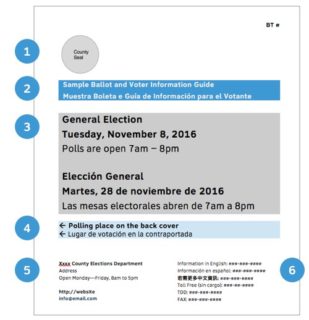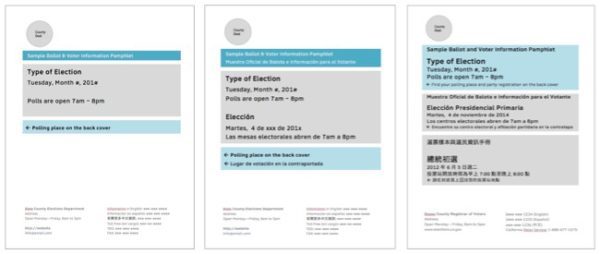Voter guide pages: Covers
The cover identifies the voter guide and what election it includes.
Lessons from the research
Experienced voters said that the information on the cover was often all they needed to know. It is a “bite” of information — the shortest possible information to answer the most important questions:
- What election is this?
- When is the election?
- Where is my polling place?
- What will this booklet tell me?
- How do I get more information, if I need it?
Because it’s just a bite of information, the cover should be clean and simple. When it is cluttered with news, messages, or warnings, it is harder to see the important information.
If all counties in state use a similar design, voters will learn to recognize the layout as their official voter guide, even if they move within the state.
About the templates
This template includes all four cover pages, each with important content.

The front cover
The template has all of this information, in clear spaces on the page.

- Who runs this election? The county seal, logo, or name at the top of the page answers this question.
- What is this? Give the guide a title. In California, the official title is Sample Ballot and Voter Information Pamphlet, but a simpler title might be just “Voter Guide” or “A Voter Guide the the Election.”
- What election is this for? Identify the election and the date. Put the times polling places are open on the cover. This information is important for voters who go to the polls on Election Day, but polling place hours are also used for many other election deadlines.
- Where do I vote? Ideally, personalized information with a polling place address can be added to the front cover. If not, identify where or how a voter can find that information.
- How do I contact you for more information? Put full contact information right on the front.
- What languages are available? If you support additional languages, show them on the cover. If the booklet is bilingual, give the information in both languages, but at a minimum have something on the cover that lets voters see what is available.
Choosing colors
If you use color on the cover, make it count. Used consistently from election to election, it can help voters and election staff quickly identify the version of the guide they need. Color can be used for:
- Guides for different kinds of voters (such as vote-by-mail, all-mail, overseas)
- Guides in different languages
- Guides for different elections, especially when special elections overlap
- Variations each year
Layout for multiple languages
The layout in the template can be used for one or two languages.
- To help differentiate the two languages, the font for the second language can be slightly smaller.
- Be sure to mark each language appropriately in Word so that screen readers know how to pronounce the words
We do not recommend including three languages in one book, but if you need to, create three blocks of information, one for each language.

→ Planning for multiple languages
The inside front cover
We suggest a letter to voters on this page that highlights any important information about the election. Putting it here will help frequent voters see updates that they need to know.
In our research, voters liked seeing the name of the head of the elections department, saying it showed that there are real people behind the election. and helps humanize government.
However, if this is an elected position, you might need to think about whether this will look like you are campaigning. The letter can still be included without a signature to avoid campaign ethics issues.
The back covers
In many guides, the mailing address is on the back cover. The address of the voter’s polling place and other personalized information is added at the same time.
Some places also include a form that voters can use to request an absentee or vote-by-mail ballot. The inside back cover has the mailing address for the postcard created when voters cut the card out using perforations or cutting on the line.
The forms on the back cover use tables to manage the layout because they are designed for printing. This means they are not accessible. Information in the voter guide or on the cover should direct voters to an accessible form. You might consider omitting these pages if you post the voter guide online.
Word tips
Covers are often printed separately from the inside pages. Ask if they should be in a separate file.
- The cover pages are not numbered. Page numbers start with the first page after the inside cover. In our template, this will be the table of contents.
- Remember that any image needs alternative text for accessibility.
- Unless your printer gives you different instructions, you can send them the files in the reading order of the pages: Front Cover, Inside Front, Inside Back and Back Cover.
On the front cover
- There is a set of styles with names starting with “Cover” to manage the text on the page. If you make a permanent edit, update the style. But for one-time changes, you can simply format the font and paragraph.
- The background colors for the different sections are created using background colors for the paragraph.
- The contact information at the bottom of the page is in two columns, so it has a good reading order for accessibility. You can insert a column break to make sure the right line ends up at the top of the second column.
On the back cover
- Be sure to talk to your printer about the location of the lines or perforations for the postcard. Make sure they are in the same place on both sides of the page.
→ Tips for accessibility
→ Tips for working in Word

